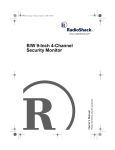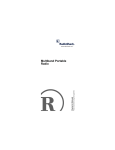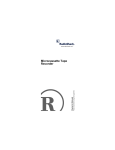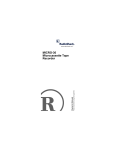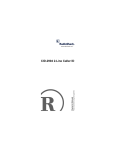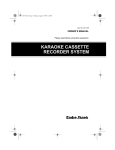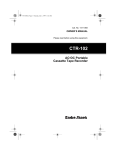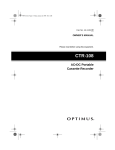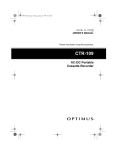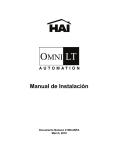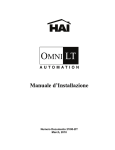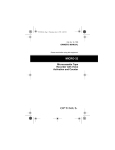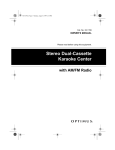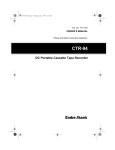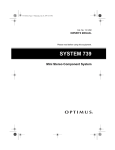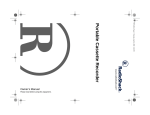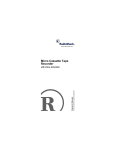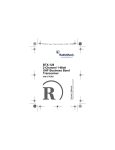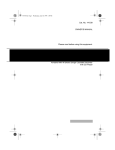Download Radio Shack CTR-117 Owner`s manual
Transcript
CTR-117 Please read before using this equipment. Owner’s Manual Voice-Activated Full Auto-Stop Cassette Recorder ! Features Your RadioShack Voice-Activated Full Auto-Stop Cassette Recorder is a portable cassette recording system that delivers quality sound from its speaker, or through an earphone or external speaker. You can use the recorder to play and record cassette tapes while you are working or playing. Because the recorder is portable, you can use it in any room or outdoors. Its features include: Microphone Jack — lets you connect an external microphone Remote Jack — lets you connect an external microphone with a remote switch. WARNING: To reduce the risk of fire or shock hazard, do not expose this product to rain or moisture. CAUTION Voice-Activated (VOX) Recording — records only when there is sound so you can save power and prevent blank sections of tape. Full Auto Stop — stops the cassette tape when it reaches its end. RISK OF ELECTRIC SHOCK. DO NOT OPEN. CAUTION: TO REDUCE THE RISK OF ELECTRIC SHOCK, DO NOT REMOVE COVER OR BACK. NO USER-SERVICEABLE PARTS INSIDE. REFER SERVICING TO QUALIFIED PERSONNEL. One-Touch Recording — lets you begin recording at the touch of a button. This symbol is intended to alert you to the presence of uninsulated dangerous voltage within the product’s enclosure that might be of sufficient magnitude to constitute a risk of electric shock. Do not open the product’s case. Pause Control — lets you temporarily stop a cassette tape during play and recording. Cue/Review Function — advances or rewinds the tape during play to help you find a section on the tape. ! Built-in Microphone — lets you record without connecting an external microphone. This symbol is intended to inform you that important operating and maintenance instructions are included in the literature accompanying this product. Tone Control — lets you customize the sound of your recorder by controlling low and high tones. © 2000 RadioShack Corporation. All Rights Reserved. RadioShack and RadioShack.com are trademarks used by RadioShack Corporation. 2 Features ! ! Preparation CONNECTING POWER Using Battery Power You can power your recorder from any of these power sources: You can power the recorder with four C batteries (not supplied). For the longest life, we recommend RadioShack alkaline batteries. • standard AC power (using the supplied AC power cord) Cautions: • four C batteries (not supplied) • vehicle battery power (with an optional DC adapter) Note: Connecting the supplied AC power cord or an adapter automatically disconnects internal batteries. Using AC Power To power the recorder from an AC outlet, connect the supplied AC power cord to the recorder’s AC POWER jack. Then plug the other end into a standard AC outlet. • Use only fresh batteries of the required size and recommended type. • Do not mix old and new batteries, different types of batteries (standard, alkaline, or rechargeable), or rechargeable batteries of different capacities. Follow these steps to install batteries. 1. Open the battery compartment by pushing on the compartment cover’s tabs and lifting the cover. Caution: Plug the supplied power cord into the recorder before you plug it into the AC outlet, and unplug the power cord from the AC outlet before you unplug it from the recorder. 2. Install the batteries according to the polarity symbols (+ and –) marked on the battery compartment door. 3. Replace the cover. Preparation 3 When the RECORD/BATTERY indicator lights during play or the sound becomes weak or distorted, or when the playing speed slows, replace the batteries. Warning: Always dispose of old batteries promptly and properly. Do not burn or bury them. Follow these steps to power the recorder from your vehicle’s battery. 1. Set the adapter’s 6V/9V switch to 6V and plug the adapter into the recorder’s DC 6V jack. Note: If you do not plan to use the recorder for a week or more, or if you plan to power it using only the supplied power cord or an adapter, remove the batteries. Batteries can leak chemicals that corrode or damage electronic circuits. Using DC Power You can power the recorder from your vehicle’s cigarette-lighter socket using a fused DC adapter, available at your local RadioShack store. 2. Insert the adapter’s other end into your vehicle’s cigarette-lighter socket. Cautions: You must use a power source that supplies 6 volts DC and delivers at least 400 mA. Its center tip must be set to negative and its plug must fit the recorder's DC 6V jack. The recommended adapter meets these specifications. Using an adapter that does not meet these specifications could damage the recorder or the adapter. ! • Plug the adapter into the recorder before you plug it into the cigarettelighter and unplug the adapter from the cigarette-lighter socket before you unplug it from the recorder. 4 CONNECTING AN EARPHONE You can use the supplied earphone to listen privately to a prerecorded tape or to monitor a recording. You can also connect an external or pillow-type speaker (not supplied) to this jack. Note: Your local RadioShack store carries a wide variety of speakers. Preparation Insert the earphone or speaker’s 1/8-inch (3.5-mm) plug into the recorder’s EAR jack. This automatically disconnects the internal speaker. mm) plug to the recorder’s MIC jack. Connecting an external microphone automatically disconnects the built-in microphone. Listening Safely To protect your hearing, follow these guidelines when you use an earphone. • Do not listen at extremely high volume levels. Extended high-volume listening can lead to permanent hearing loss • Set the volume to the lowest setting before you begin listening. After you begin listening, adjust the volume to a comfortable level. • Once you set the volume, do not increase it. Over time, your ears adapt to the volume level, so a volume level that does not cause discomfort might still damage your hearing. Traffic Safety Do not wear an earphone while operating a motor vehicle or riding a bicycle. This can create a traffic hazard and could be illegal in some areas. Note: Your local RadioShack store carries a variety of microphones. If you are using a microphone with a remote switch, insert the microphone’s sub-mini plug into the cassette deck’s REMOTE jack. You can use the microphone’s remote switch to start and stop the cassette deck during play and recording. CONNECTING AN EXTERNAL AUDIO SOURCE You can use your recorder to record from an external audio source, such as a radio, cassette deck, or CD player. Even though some earphones let you hear some outside sounds when listening at normal volume levels, they still can present a traffic hazard. CONNECTING AN EXTERNAL MICROPHONE You can connect an external microphone (not supplied) with a 1/8-inch (3.5- Disconnect any external microphone from the recorder (an external microphone disables input to the AUX jack). Preparation 5 Use an 1/8-inch (3.5 mm) patch cord to connect the recorder’s AUX jack to the audio source’s audio output jack. ! Operation You can use your recorder to make recordings or to play your favorite cassette tapes. 3. Insert a cassette into the door’s tape guides with the side you want to play facing up and the exposed tape edge facing you. LOADING A CASSETTE TAPE 1. Take up any slack in the tape by turning the hub with a pencil. If you do not remove excess slack, the tape might become tangled in the record/playback mechanism. Avoid touching the tape. 4. Close the cassette compartment door. PLAYING A CASSETTE TAPE 1. Load a cassette tape. 2. Press PLAY. The tape begins to play, moving from the left reel to the right reel. 2. Press STOP/EJECT to open the cassette compartment door. 6 Operation 3. Rotate VOLUME and TONE to the desired settings. on the tape. When you release CUE/ FAST-F or REVIEW/REWIND, the recorder resumes normal play. Using the Tape Counter 4. When the cassette tape reaches its end, the cassette deck automatically releases PLAY and stops the tape. To stop it sooner, press STOP/ EJECT. You can use the tape counter to note different locations on your tape during recording or playback. Before playing or recording a cassette tape, rewind the cassette tape and press TAPE COUNTER to set the counter to 000. As the cassette tape moves, the counter advances. Using Fast Forward and Rewind To advance or rewind the tape, press CUE/FAST-F or REVIEW/REWIND when the cassette deck is stopped. The cassette tape winds forward or backward until it reaches the end or until you press STOP/EJECT. REVIEW REWIND Using Pause You can temporarily stop the tape by pressing PAUSE while you are recording or playing a cassette tape. Press PAUSE again to resume playing or recording. RECORDING Note: When the tape is fully wound to either reel, the cassette deck automatically releases CUE/FAST-F or REVIEW/ REWIND. Using Cue and Review To rapidly advance or rewind the tape during play, hold down CUE/FAST-F or REVIEW/REWIND. This feature allows you to quickly locate any desired section You can record to a cassette tape on the recorder from the built-in microphone, an external microphone, or an external audio source. For the best performance, use regular length (60-minute or 90-minute) cassette tapes. We do not recommend 120minute cassette tapes because they are thin and can tangle easily. For lownoise, wide-range recordings, use only normal-bias tapes. Operation 7 Note: Be sure the erase-protection tabs are in place on the cassette tape. See “Preventing Accidental Erasure” on Page 9. If you set ALC to OUT, adjust VOLUME so the LEVEL METER lights to 0 dB during the loudest portions of the sound signal. Follow these steps to record. 1. Load a cassette tape into the cassette deck. 2. Set VOX to OUT if you want to manually start and stop recording. Or, set VOX to HIGH or LOW, depending on the sound source you want to record. 4. If you are recording from an external audio source’s line level output jack, set ALC to IN. The recorder will automatically adjust the recording level. If you are recording from an external audio source’s phones jack, turn on the external audio source and set its volume to a comfortable listening level before you connect it to the recorder (see “Connecting an External Audio Source” on Page 5). Then use the recorder’s VOLUME control to set the recording level according to the LEVEL METER. HIGH is the most sensitive setting and requires only a soft sound to begin recording. LOW is the least sensitive setting and requires a louder sound to begin recording. 3. Set the recorder’s automatic level control (ALC) to IN to have the recorder automatically adjust its recording level or to OUT so you can manually adjust the recording level for unusually loud or soft sounds. 8 5. Press RECORD to begin recording. RECORD and PLAY both lock down. The RECORD/BATTERY indicator lights. Operation Notes: • To monitor what the recorder is recording from an external audio source, insert the supplied earphone’s plug into the EAR jack on the recorder. • To temporarily stop recording, press PAUSE. To resume recording, press PAUSE again. Caution: Be careful not to damage the cassette when tapping it. Do not touch the exposed tape or allow any sharp objects near the cassette. Erasing Tapes To record over a cassette tape, insert the supplied dummy plug into the recorder’s MIC jack and record as usual. The cassette deck records over the previous recording. To record over the entire cassette tape, let the tape record to the end on both sides. When you finish, remove the plug. You can quickly erase both sides of a cassette tape using a bulk tape eraser (available at your local RadioShack store). 6. If the cassette tape reaches its end, the cassette deck automatically releases RECORD and PLAY and stops. To stop recording sooner, press STOP/EJECT. TAPE TIPS Note: If you use metal or high-bias type tape, the recorded sound might not be erased properly. Preventing Accidental Erasure Cassette tapes have two erase-protection tabs — one for each side. When a tab is in place, you can record on that side. Restoring Tape Tension and Sound Quality After you play a cassette tape several times, the tape might become tightly wound on the reels. This can cause playback sound quality to deteriorate. To restore the sound quality, fast-forward the tape from the beginning to the end of one side, then completely rewind it. Then loosen the tape reels by gently tapping each side of the cassette’s outer shell on a flat surface. Operation 9 To prevent accidental erasure of a tape recording, use a screwdriver to remove one or both of the cassette tape’s eraseprotection tabs. This prevents RECORD from being pressed. If you later decide to record on a tape side after you have removed the eraseprotection tab, place a piece of strong plastic tape over that side’s erase-protection hole. Be sure you cover only the hole originally covered by the erase-protection tab. Caution: Removing the erase-protection tabs does not prevent a bulk eraser from erasing a cassette tape. ! Care Keep the recorder dry; if it gets wet, wipe it dry immediately. Use and store the recorder only in normal temperature environments. Handle the recorder carefully; do not drop it. Keep the recorder away from dust and dirt, and wipe it with a damp cloth occasionally to keep it looking new. parts or use a cassette deck cleaning kit (available at your local RadioShack store). Modifying or tampering with the recorder’s internal components can cause a malfunction and might invalidate its warranty. If your recorder is not performing as it should, take it to your local RadioShack store for assistance. CLEANING THE TAPEHANDLING PARTS Dirt, dust or particles of the tape's coating can accumulate on the tape heads and other parts that the tape touches. This can greatly reduce the performance of the cassette player. After every 20 hours of tape player operation, follow these steps to clean the tape-handling 10 Care 1. Remove the batteries and disconnect any other power source. 2. Open the cassette compartment door and press PLAY to expose the tape-handling parts. 3. Use a cotton swab dipped in denatured alcohol or tape head cleaning solution to clean the tape guides, record/play head, erase head, pinch roller, and capstan. Tape Guides Capstan Erase Head Record/Playback Head Pinch Roller 4. When you finish cleaning, press STOP/EJECT and close the cassette compartment door. Then reconnect power. Care 11 ! Specifications Cassette Deck Tape Speed ................................................................................................ 17/8 ips (4.8 cm/sec) Tape System ............................................................................................. Two Track, Monaural Recording System ......................................................................................................... AC Bias Erasing System .......................................................................................................... DC Erase General Output Power at 10% THD ........................................................... 500 mW (AC), 600 mW (DC) Speakers ........................................................................................ Dynamic, 3 Inches (76 mm) Power Supply ..................................................................................................... AC 120V/60Hz DC 6V, C Batteries × 4 External DC 6V Adapter Dimensions (WHD) ........................................ 97/8 × 62/3 × 23/8 Inches (251.6 × 169 × 59.8 mm) Weight (without batteries) .................................................................................... 23/16 lbs (1 kg) Specifications are typical; individual units might vary. Specifications are subject to change and improvement without notice. Limited Ninety-Day Warranty This product is warranted by RadioShack against manufacturing defects in material and workmanship under normal use for ninety (90) days from the date of purchase from RadioShack company-owned stores and authorized RadioShack franchisees and dealers. EXCEPT AS PROVIDED HEREIN, RadioShack MAKES NO EXPRESS WARRANTIES AND ANY IMPLIED WARRANTIES, INCLUDING THOSE OF MERCHANTABILITY AND FITNESS FOR A PARTICULAR PURPOSE, ARE LIMITED IN DURATION TO THE DURATION OF THE WRITTEN LIMITED WARRANTIES CONTAINED HEREIN. EXCEPT AS PROVIDED HEREIN, RadioShack SHALL HAVE NO LIABILITY OR RESPONSIBILITY TO CUSTOMER OR ANY OTHER PERSON OR ENTITY WITH RESPECT TO ANY LIABILITY, LOSS OR DAMAGE CAUSED DIRECTLY OR INDIRECTLY BY USE OR PERFORMANCE OF THE PRODUCT OR ARISING OUT OF ANY BREACH OF THIS WARRANTY, INCLUDING, BUT NOT LIMITED TO, ANY DAMAGES RESULTING FROM INCONVENIENCE, LOSS OF TIME, DATA, PROPERTY, REVENUE, OR PROFIT OR ANY INDIRECT, SPECIAL, INCIDENTAL, OR CONSEQUENTIAL DAMAGES, EVEN IF RadioShack HAS BEEN ADVISED OF THE POSSIBILITY OF SUCH DAMAGES. Some states do not allow limitations on how long an implied warranty lasts or the exclusion or limitation of incidental or consequential damages, so the above limitations or exclusions may not apply to you. In the event of a product defect during the warranty period, take the product and the RadioShack sales receipt as proof of purchase date to any RadioShack store. RadioShack will, at its option, unless otherwise provided by law: (a) correct the defect by product repair without charge for parts and labor; (b) replace the product with one of the same or similar design; or (c) refund the purchase price. All replaced parts and products, and products on which a refund is made, become the property of RadioShack. New or reconditioned parts and products may be used in the performance of warranty service. Repaired or replaced parts and products are warranted for the remainder of the original warranty period. You will be charged for repair or replacement of the product made after the expiration of the warranty period. This warranty does not cover: (a) damage or failure caused by or attributable to acts of God, abuse, accident, misuse, improper or abnormal usage, failure to follow instructions, improper installation or maintenance, alteration, lightning or other incidence of excess voltage or current; (b) any repairs other than those provided by a RadioShack Authorized Service Facility; (c) consumables such as fuses or batteries; (d) cosmetic damage; (e) transportation, shipping or insurance costs; or (f) costs of product removal, installation, set-up service adjustment or reinstallation. This warranty gives you specific legal rights, and you may also have other rights which vary from state to state. RadioShack Customer Relations, 200 Taylor Street, 6th Floor, Fort Worth, TX 76102 We Service What We Sell RadioShack Corporation Fort Worth, Texas 76102 12/99 14-1123 B 811081560C 11A00 Printed in China












